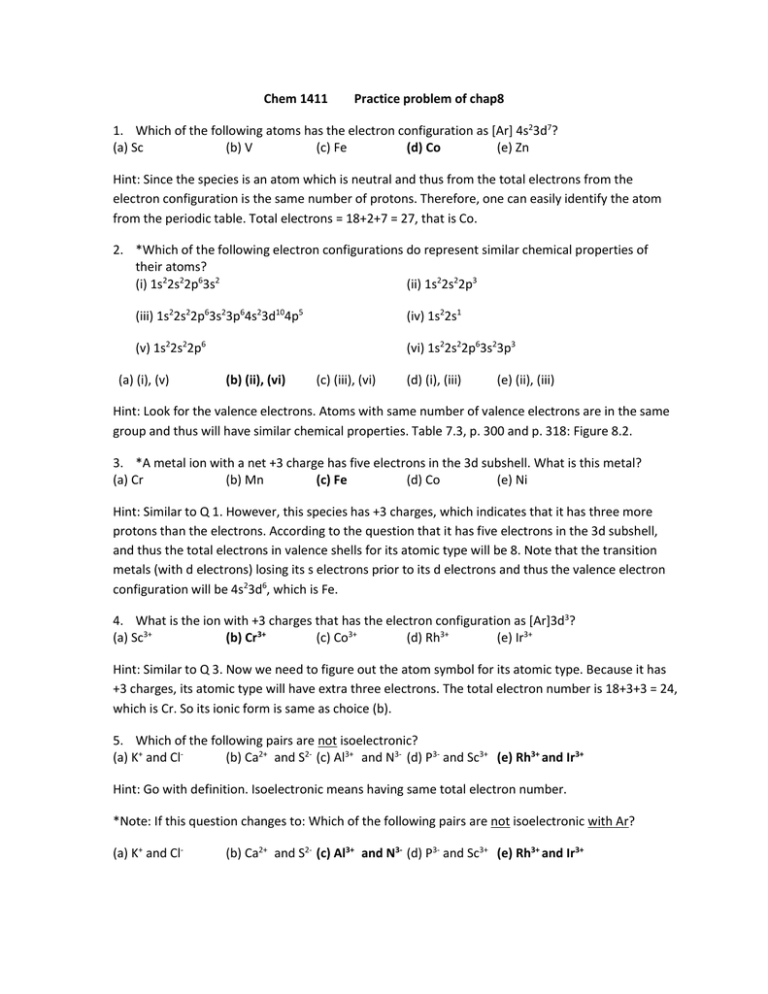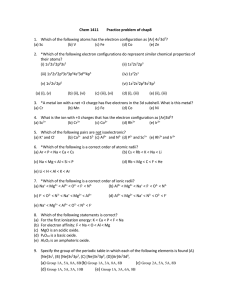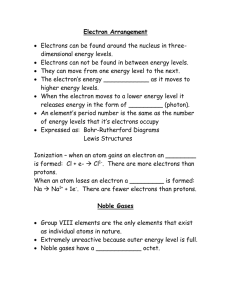Practice problem of chap8.doc
advertisement

Chem 1411 Practice problem of chap8 1. Which of the following atoms has the electron configuration as [Ar] 4s23d7? (a) Sc (b) V (c) Fe (d) Co (e) Zn Hint: Since the species is an atom which is neutral and thus from the total electrons from the electron configuration is the same number of protons. Therefore, one can easily identify the atom from the periodic table. Total electrons = 18+2+7 = 27, that is Co. 2. *Which of the following electron configurations do represent similar chemical properties of their atoms? (i) 1s22s22p63s2 (ii) 1s22s22p3 (iii) 1s22s22p63s23p64s23d104p5 (iv) 1s22s1 (v) 1s22s22p6 (vi) 1s22s22p63s23p3 (a) (i), (v) (b) (ii), (vi) (c) (iii), (vi) (d) (i), (iii) (e) (ii), (iii) Hint: Look for the valence electrons. Atoms with same number of valence electrons are in the same group and thus will have similar chemical properties. Table 7.3, p. 300 and p. 318: Figure 8.2. 3. *A metal ion with a net +3 charge has five electrons in the 3d subshell. What is this metal? (a) Cr (b) Mn (c) Fe (d) Co (e) Ni Hint: Similar to Q 1. However, this species has +3 charges, which indicates that it has three more protons than the electrons. According to the question that it has five electrons in the 3d subshell, and thus the total electrons in valence shells for its atomic type will be 8. Note that the transition metals (with d electrons) losing its s electrons prior to its d electrons and thus the valence electron configuration will be 4s23d6, which is Fe. 4. What is the ion with +3 charges that has the electron configuration as [Ar]3d3? (a) Sc3+ (b) Cr3+ (c) Co3+ (d) Rh3+ (e) Ir3+ Hint: Similar to Q 3. Now we need to figure out the atom symbol for its atomic type. Because it has +3 charges, its atomic type will have extra three electrons. The total electron number is 18+3+3 = 24, which is Cr. So its ionic form is same as choice (b). 5. Which of the following pairs are not isoelectronic? (a) K+ and Cl(b) Ca2+ and S2- (c) Al3+ and N3- (d) P3- and Sc3+ (e) Rh3+ and Ir3+ Hint: Go with definition. Isoelectronic means having same total electron number. *Note: If this question changes to: Which of the following pairs are not isoelectronic with Ar? (a) K+ and Cl- (b) Ca2+ and S2- (c) Al3+ and N3- (d) P3- and Sc3+ (e) Rh3+ and Ir3+ 6. *Which of the following is a correct order of atomic radii? (a) Ar < P < Na < Ca < Cs (b) Cs < Rb < K < Na < Li (c) Na < Mg < Al < Si < P (d) Rb < Mg < C < F < He (e) Li < H < Al < K < Ar Hint: Periodic trend: p. 324: Figure 8.5 and Example 8.2. 7. *Which of the following is a correct order of ionic radii? (a) Na+ < Mg2+ < Al3+ < O2- < F- < N3(b) Al3+ < Mg2+ < Na+ < F- < O2- < N3(c) F- < O2- < N3- < Na+ < Mg2+ < Al3+ (d) Al3+ < Mg2+ < Na+ < N3- < O2- < F- (e) Na+ < Mg2+ < Al3+ < O2- < N3- < FHint: p.p.325-327, Figure 8.9 and Example 8.3. 8. (a) (b) (c) (d) (e) Which of the following statements is correct? For the first ionization energy: K < Ca < P < F < Na For electron affinity: F < Na < O < Al < Mg MgO is an acidic oxide. P4O10 is a basic oxide. Al2O3 is an amphoteric oxide. (f) Hint: Periodic trend: p. 324: Figure 8.5 and Example 8.2. and p.p.325-327, Figure 8.9 and Example 8.3. Ionization energy: p.p. 329-333. Electron affinity: p.p. 333-335. Oxides: p.p. 344-347: Table 8.4 and Example 8.6. 9. Specify the group of the periodic table in which each of the following elements is found (A) [Ne]3s1, (B) [Ne]3s23p3, (C) [Ne]3s23p6, (D)[Ar]4s23d8, (a) Group 1A, 5A, 8A, 8B (d) Group 1A, 5A, 5A, 10B (b) Group 1A, 3A, 8A, 8B (e) Group 1A, 3A, 6A, 8B (c) Group 2A, 5A, 5A, 8B Hint:p.p.318 Fig8.2. Identify the electron configuration of each group. 10. *Arrange the following in order of the increasing first ionization energy: Na, Cl, Al, S, Cs (a) Na< Cs < Al < S < Cl (b) Cs < Na< S < Al < Cl (c) Cs < Na < Al < S < Cl (d) < Al Cs < Na < S < Cl (e) Cs < Na < Cl < Al < S Hint: Ionization energy increases across a row of the periodic table and decreases down a column or group. 11. *Which of the following statement is correct concerning the change of chemical properties of oxides across the period or within a group? (a) From left to right across a period, oxides change from basic to amphoteric to acidic. Going down a group, the oxides become more basic. (b) From left to right across a period, oxides change from acidic to amphoteric to basic. Going down a group, the oxides become more basic. (c) From left to right across a period, oxides change from basic to amphoteric to acidic. Going down a group, the oxides become more acidic. (d) From left to right across a period, all the oxides are acidic. Going down a group, the oxides become more basic. (e) From left to right across a period, all the oxides are basic. Going down a group, the oxides become more basic.



